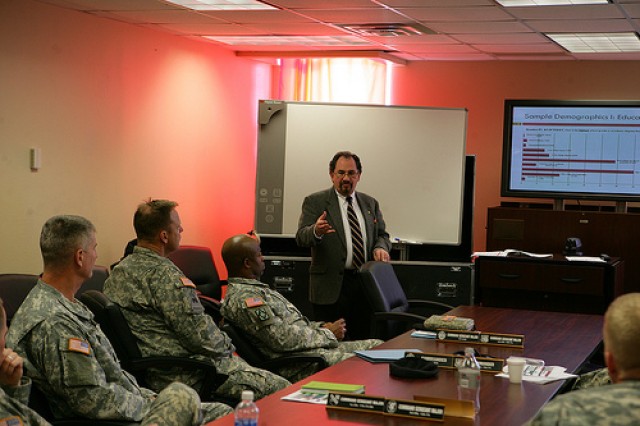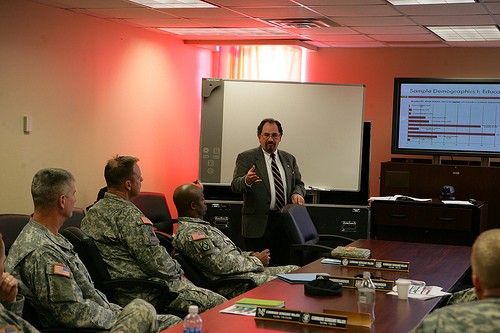
FORT SILL, Okla. --The 75th Fires Brigade received a house call from a doctor last month and to their relief, they were given a clean bill of health.
Dr. David Segal came to Fort Sill but he wasn't checking for things like the flu. Instead the focus was on the strains caused by the current operation tempo on Soldiers and ways to find a cure.
"As a bottom line, I will tell you, on the basis of the first survey we got, this is a pretty healthy brigade," said Segal. He is a professor of sociology at the University of Maryland who has been studying the Army for almost 40 years. His expert opinion has been called upon for various topics in the military ranging from gender integration to gays in the military.
Col. Joseph Harrington, 75th FiB commander, asked for his view on an experimental physical training schedule the brigade has been using since October. In it, Soldiers report to duty at 8 a.m., gather for PT at 3:30 p.m. and are released for the day afterwards unless more work/training needs to be accomplished. The sole purpose of this schedule is to allow Soldiers to get more sleep and hopefully ease the effects of deployments while they're in the reset phase.
"The Army is not about to say to the national command structure, Mr. President we can't do all of the things you're asking us to do. So, the Army is finding ways to do it. One of the ways is to deploy Soldiers for long periods of time and to deploy them frequently. These are changes in the way we do business and all of these things have costs," said Segal.
The costs he is referring to is Soldiers' well-being which also tends to overflow into the Soldiers' family lives.
Maj. Marc Hultquist, 75th FiB surgeon, came up with this PT schedule after attending a meeting at the Military Child and Adolescent Center of Excellence. There, the topic was the difficulties young families are having surviving military life and frequent deployments. After much research Hultquist also found the number of Soldiers on medication for sleep drastically increased since the war in Iraq began. So he decided a slight change in schedule might kill two birds with one stone.
"Soldiers who don't sleep have problems getting back into a normal routine and then we give them sleep medicine, but yet they have to get up at 4:30 in the morning the next day. It would be easy to say go to sleep earlier but when you have family and you have children to put to bed and they have homework that keeps them up until 9 or 9:30 p.m.," Hultquist said, "or you're a single Soldier trying to go to school and have professional development, etc. So the thought process was that if we just switch the PT and had a later workday formation, then we could get potentially 90 minutes more sleep which, for most people, would complete a natural sleep cycle."
Segal agreed it is a good plan but wants to make sure the results confirm it's working.
"You know they don't even have to show that it improves physical fitness scores. If we can show that we're not losing in physical fitness but are holding constant there and people are getting more sleep, then that's a net gain," said Segal.
Of course, Segal also suggested looking for unintended consequences to the new schedule which Harrington is staying on top of. Unfortunately, determining all of the effects takes a lot of time and research and determining the exact cause of each one can be a daunting task. For example, some Soldiers in the brigade are still under the impression that switching to afternoon PT was simply because of the weather. Segal suggested they might not even be paying attention to their sleep as a problem.
"There are Soldiers out there who literally don't realize they're getting more sleep with afternoon PT until I walk them through it," said Hultquist. "I ask them are you getting more sleep' 'No.' What time do you go to bed' 'Ah, now it's 10 p.m.' What time do you wake up '6:30, 6:45.' What time were you waking up for morning PT' '4:30 a.m.' What time did you go to bed then' '10 p.m. Oh! I'm getting more sleep."
There are some other positive side effects Hultquist believes the schedule could create, like Soldiers making healthier food choices or consuming less food knowing they will have to workout at the end of the day.
Hultquist stated they may also consume less caffeine for the same reason which would ultimately help most Soldiers fall asleep easier. Harrington added it could cut also down on driving on and off post, and the Soldiers would ultimately go home more relaxed from working out their stress at the end of the day.
These effects have not been confirmed yet, but that is the purpose of the research.
"It's an intervention that doesn't directly address the cause of the problem, but it potentially improves the quality of life and the mental health of the Soldier and the mental health of the Soldier's family," said Segal.
During their visit Segal along with a doctoral student, Marek Posard, focused on Soldier morale, and work-family conflict as indicators of how the system is working. They shared their findings with the leaders of the brigade from the first round of surveys, which were taken early after the PT switch, along with what they learned in focus groups with noncommissioned officers in the brigade.
Interestingly enough the range in rank in the NCOs seemed to have a drastic effect on the conversations.
"First of all the older people, who by definition are generally more senior NCOs, were the ones who were likely to talk. And, they were also the ones who were more likely to be negative towards afternoon PT. The younger people, if they disagreed, tended to keep quiet. So, I suspect what we were actually hearing and what we have in our records is more negative than the actual sentiment of the battalion," said Segal.
Posard said outside of the focus group the younger NCOs actually shared positive comments regarding afternoon PT.
Segal suggested in the future he would hold rank constant to avoid a skewed response in focus groups. From the first round of survey results Soldiers were open in saying there are some costs to their family associated with their military service, but overall they were still very positive about the switch.
"A lot of Soldiers we talked to said there are tremendous gains to their families from afternoon PT, but there are costs in terms of their ability to get the work done. And they see that as a trade off. Most of them, although they say their family is a priority, see that the most important thing is getting the work done. They're frustrated at not being able to get the work done. If we could reduce that feeling and have them say there is some intervention in the brigade whether it's afternoon PT or whatever that improves both their family life and their ability to get work done that would be great," said Segal.
Harrington comically suggested the creation of a 25-hour work day.
Segal wants to continue looking at results as the brigade continues afternoon PT, as well as the results after they go back to a traditional PT schedule. As for his expert opinion on continuing this kind of schedule based on what they know now, Segal would not recommend it be instituted Army-wide neither would he recommend that it be terminated.
"This is a snapshot. What I want to look at is the motion picture. In that motion picture we have to take into account the various things that are being done in all of these units that might affect us," said Segal.
Segal, Hultquist and Harrington will continue to have a conversation about the effects of afternoon PT. In the meantime, the brigade will switch back to the traditional PT schedule in April due to high temperatures in the spring and summer.

Social Sharing